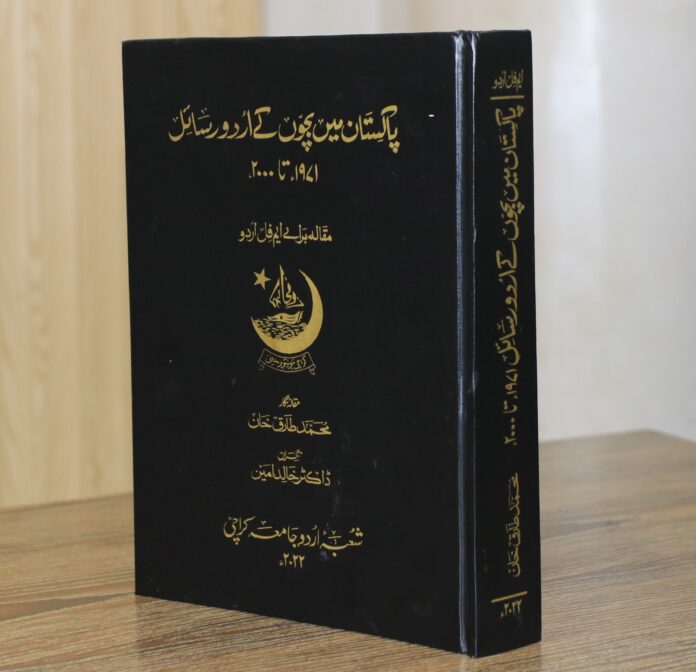 Obaid Raza
Obaid Raza
Today, MA, M Phil, and PhD level articles are being written on Urdu literature. Muhammad Tariq Khan, former editor-in-chief of the children’s magazine “Sathee” and author known by the pen name Azam Tariq Kohistani, has completed his MA on “Children’s Urdu Journals in Pakistan from 1971 to 2000” under the supervision of Dr. Khalid Amin at the University of Karachi. The subject of his article starts from 1971 because Mahmoodur Rahman had already worked on literature until 1970.
Azam Tariq Kohistani divided his article into five chapters, the first of which is titled “Children’s Literature: Nature and Development, from the Beginning to 1971”. An attempt has been made to answer the question of what children’s literature is at the beginning of the article. The author has stated several important points in this regard that are necessary for any writing to be considered as children’s literature. For example, it is said that the songs that are sung to calm and lull children, such as lullabies, are also children’s literature. The writings that are written for adults but are more popular among children, such as Henry Esmound’s book The Adventures of Tom Sawyer, will also be counted as children’s literature. It has also been mentioned as a sign of children’s literature that when a child picks up a book, they do not get bored and put it back. When there is music in poetry and it evokes emotions, it becomes more interesting for children.
The article criticizes the use of difficult vocabulary in writing for children, stating that children’s literature should contain everything that children can read, listen to, and understand with enthusiasm. The use of overly complicated words or an excessive focus on teaching new vocabulary can make children bored and uninterested in reading.
The article also discusses the characteristics of children’s literature, stating that children’s minds are not always logical, and they may not follow the same rules of logic as adults. Therefore, when writing for children, authors often use anthropomorphic language, converse with them through toys and objects, and avoid logical inconsistencies.
The second part of the first chapter delves into the history of children’s literature in the Urdu language. The researchers trace the beginning of Urdu literature for children to the era of Emperor Alamgir, when the first formal books for children were written. These books were mainly written to teach and educate children, and to introduce them to new vocabulary.
During this time, well-known poets such as Hali, Iqbal, Nazir Akbarabadi, Ismail Merthi, etc. wrote countless poems and literary works for children. Later, in the beginning of the 20th century, the first children’s newspaper, “Bachon Ka Akhbar”, was launched. This was followed by the launch of other periodicals such as “Haft Roza Phool,” “Ataleeq,” “Adib ul-Atfal,” “Ghuncha,” “Nunehaal,” etc.
The first chapter ends by highlighting the most important and best aspect of the article, which is the reference to Urdu literary magazines for children. A total of 383 magazines have been identified, which serve as a symbol of the rich literary history of Urdu for children.
In the second chapter, the author has reviewed the period from 1971 to 2000 and presented a list of 173 research papers published from Pakistan during or after 1971. The research work started in 1971, as mentioned in the article, when Mahmood-ul-Rahman wrote an article on children’s literature until 1970. Some research papers have been continuously published for several decades, such as Taleem-o-Tarbiat, Hamdard Naunehal, and Sathee, published in 1941, 1953, and 1977, respectively. The author has analyzed in detail the three mentioned research papers and the popular and famous research papers published from 1986 to 1997, in the article.
After reviewing each of the four research papers, the author has analyzed the language, themes, quality, illustrations, cover page, cartoons, sketches, etc. of the stories and poems in the research papers. An exhaustive list of the best stories and poems is also included in each research paper’s analysis, along with other details such as editors, important contributors, changes in the research paper’s size, increase or decrease in the number of pages, special issues, awards, and other regular features.
This chapter presents various examples of stories and poems that have been quoted and excerpted. During research, the author searched for a travelogue that was published in “Taleem-o-Tarbiat” and found one that predates Masood Ahmed Barkati and Hakim Saeed’s travelogues. Khalid Bazmi’s travelogue was published in 1977 in “Taleem-o-Tarbiat”, while Barkati’s was published in 1982. (Prior to both of these, a travelogue was also published in “Peyam-e-Taleem” in 1943.)
The second section of the article is the main part upon which a lot of time and effort has been spent, and undoubtedly, this research will serve as a guide for those researching children’s literature in the future.
The third section focuses on important poets and authors from 1971 to 2000, featuring 20 authors. In prose, Mirza Adeeb, Hakim Saeed, Ay Hamid, Ishtiaq Ahmed, Masood Barkati, Shafiq-ur-Rahman, Saeed Lakht, Saleem Maghul, Ibn-e-As Muhammad, and Naeem Ahmed Baloch, among others, are included. We can say that an attempt has been made to dam the river in a pot. Mirza Adeeb wrote stories, but he excelled in writing plays for children. (He left writing plays at the suggestion of Syed Qasim Mahmood later on.
Hakim Muhammad Saeed did a great job of publishing and translating books for children, including “Hamdard Naunehal” for children. However, he himself wrote the most travelogues for children.
Ay Hamid wrote many fantasy series, including “Amber Nag Maria”, “Eyewear Wala Jin”, and many others. Thus, he is a representative writer in Urdu literature for children’s fantasy writing.
Ahmed’s enthusiasm led him to write spy stories for children, while Islamic literature includes Talib Hashmi, Kalim Chughtai, Ibn-e-As Muhammad, and Naeem Ahmed Baloch in collections of stories and novels.
Talking about humorous literature, Saeed Lakht (Hafeez Jalandhari) and Idris Qureshi (Chacha Hameed) became famous for writing quality humor for children. In the field of novel writing, Munir Ahmed Rashid’s Commando series is still read today, while Begum SaeqaRahimuddin and Seema Siddiqui contribute to commentary and articles on women’s issues.
Ten personalities are included in the poets’ category. The poetry of Sufi Tabassum, Ibn-e-Insha, Qayyum Nazar, Inayat Ali Khan, Tanveer Phool, and Ahmad Hafeez Siddiqui, among others, is discussed in relation to their services to Urdu literature for children. Both prose and poetry adaptations are included in this section.
The fourth chapter discusses the impact of children’s literature on the society of children. Children’s lives and habits cannot be improved without standard literature. The diversity of literature and its various topics help to complete different aspects of children’s personality in society, which is highlighted in this chapter through four fundamental points. It is a complex issue to determine which good habits and morals children acquire from stories in their childhood. However, according to human psychology, even those children who are deprived of books and literature in their childhood or are limited to only prescribe textbooks can still compare the impact of literature in their daily lives.
The author praises Azam Tariq Kohistani for his critical study of forty years of four Urdu literary magazines, which involved sifting through vast amounts of material and finding gems among the rubble.



